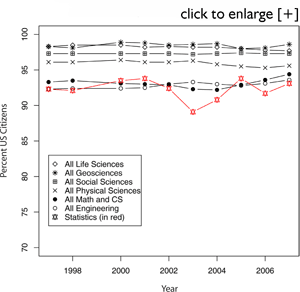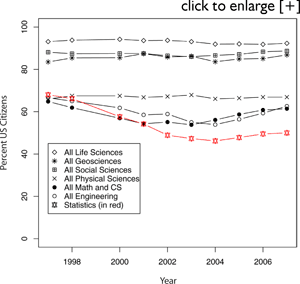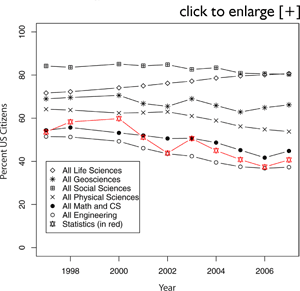Low Percentage of U.S. Citizens Earning Statistics Degrees Compared to Other STEM Disciplines
Keith Crank, ASA Research and Graduate Education Manager
Statistics Updates
News Flash
U.S. News and World Report will be surveying statistics departments separately from mathematics departments for their rankings of graduate programs. For the first time, the rankings of statistics departments will be based on reports from other statisticians.
Survey of Statistics and Biostatistics Departments
Last spring, the ASA conducted its second annual survey of PhD-granting departments of statistics and biostatistics. Approximately half of the statistics departments and a third of the biostatistics departments responded to the questionnaire. A report on the results is available here.
NSF Program Officers in Statistics and Probability
As the new academic year begins, there are changes in the Statistics and Probability Program at the National Science Foundation (NSF). Gabor Szekely remains a permanent employee; David Stoffer of the University of Pittsburgh continues for a second year; and Grace Yang returns to NSF, replacing Yazhen Wang, who moved to the University of Wisconsin. Tomek Bartoszynski remains the program director for probability. The current program directors are the following:
Gabor Szekely (gszekely@nsf.gov)
David Stoffer (dstoffer@nsf.gov)
Grace Yang (gyang@nsf.gov)
Tomek Bartoszynski (tbartosz@nsf.gov)
While at JSM, I mentioned to at least two audiences that statistics has the lowest percentage of degree recipients who are U.S. citizens, when compared to other STEM (science, technology, engineering, and mathematics) disciplines at all degree levels. Although no one questioned this at JSM, I have received emails about it since.
Since 2002, statistics has had lower percentages of U.S. citizens receiving degrees than all the other disciplines at the bachelor’s and master’s levels (except for bachelor’s degrees in 2005). At the PhD level, only engineering has lower percentages. (Click here for graphs that separate the broad disciplines into their component fields.)
Why does this matter? There are two main reasons. First, foreign citizens are less likely than U.S. citizens to remain in the United States once they earn their degree. Unless there are comparable numbers of U.S. citizens going abroad to pursue degrees in statistics, this could lead to a drain on U.S. resources. (Although I have no data on U.S. citizens pursuing degrees at foreign institutions, I would be surprised if the numbers were comparable to the number of foreign students pursuing degrees in the United States.)
The second reason is that a primary employer of statisticians is the U.S. government, and the main government agencies that hire statisticians require U.S. citizenship. The low percentage of U.S. citizens earning statistics degrees produces a much smaller pool of potential employees for these agencies.
Included here are three graphs that compare the percentage of degrees awarded to U.S. citizens by broad STEM discipline to the percentage awarded in statistics (including biostatistics). There are separate graphs for the three degree levels. The graphs cover 1997–2007 (except 1999, for which there are no data.). The data come from the Integrated Postsecondary Education Data System, which is maintained by the National Center for Education Statistics.
Citizenship of Bachelor’s Degree Recipients Statistics Compared with Broad STEM Fields
Citizenship of Master’s Degree Recipients Statistics Compared with Broad STEM Fields
Citizenship of PhD Degree Recipients Statistics Compared with Broad STEM Fields
To contact me, send an email to keith@amstat.org. Questions or comments about this article, as well as suggestions for future articles, are always welcome.




















